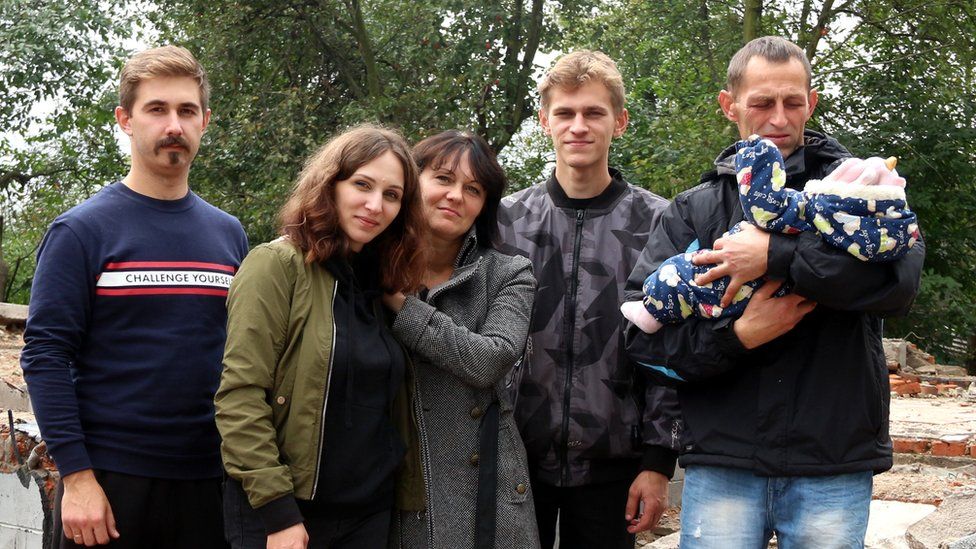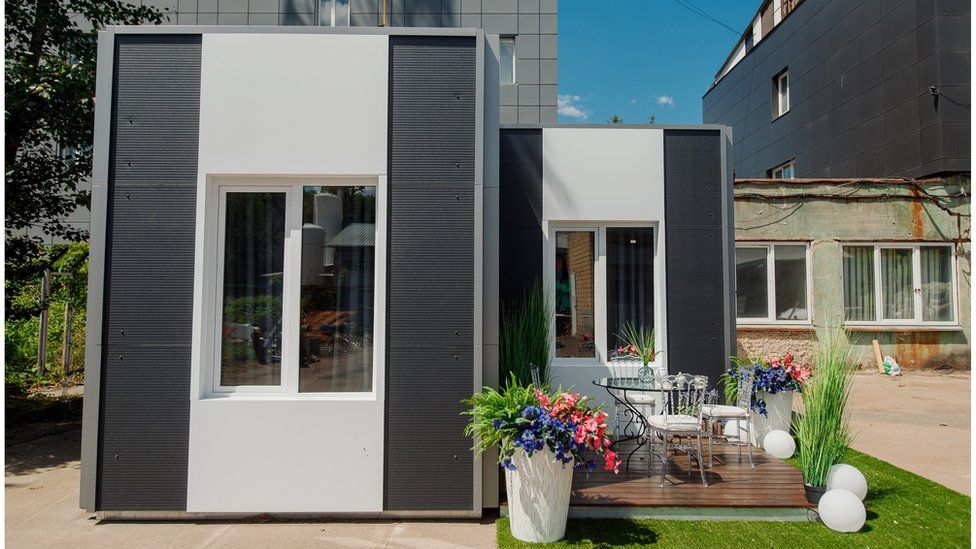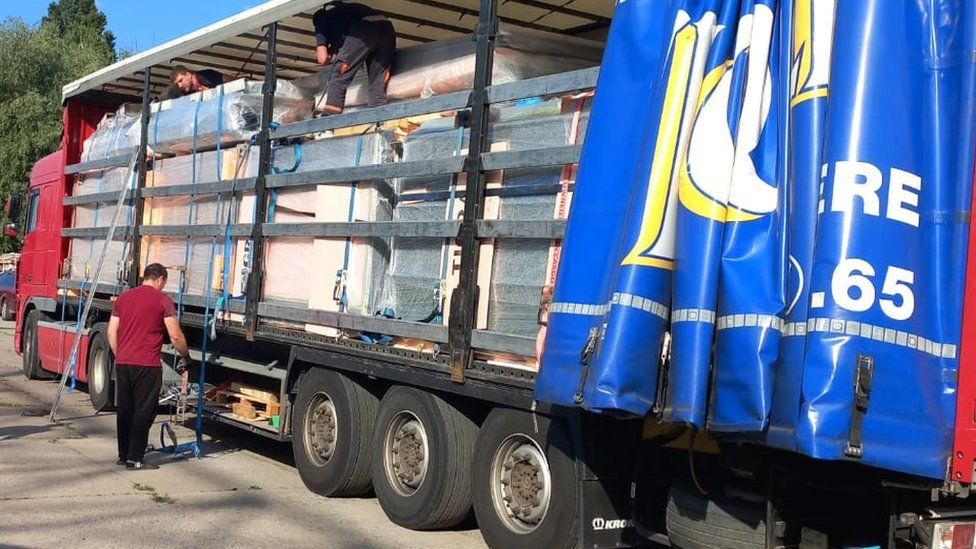The flatpack homes rehousing Ukrainian families

In mere minutes, her house went from a family home to a blazing pile of rubble. “Everywhere was fire,” recalls Alla Pylypenko, a teacher, as she describes the terrible afternoon last March when Russian tanks attacked her village in the Chernihiv region of Ukraine. Shells struck the house, she says.
There’s emotion in her voice as she explains what the building used to be like.
An old photo she sends via WhatsApp shows a large property with balconies and a pond in the front garden. Images taken after the attack capture the soot-stained, crumbling walls left by the assault.
But Mrs Pylypenko and her family now have a new home in the garden of their old one – a factory-made house that was assembled in just a few days last autumn.
The building, a donation to the family, was one of the first homes of its kind built by Ukrainian firm HOMErs, which says its designs could benefit millions of refugees and people still in Ukraine who have lost their properties in the conflict.
HOMErs, previously known as Tera Monada, has a range of modular houses, made from standardised factory-made units that slot together quickly to achieve the desired final design.

Given the extent of damage in Ukraine, any reconstruction efforts will have to be both fast and cost-effective. In March, the World Bank estimated that it could take $411bn (£323bn) to rebuild the country. President Volodymyr Zelenskyy has, in the past, put the figure at $1tn.
“There are about 200 destroyed houses in my community,” says Mrs Pylypenko. “Modular houses are absolutely important for us.”
Her new property is significantly smaller than her old one, she notes. But it is the only such building in her village and accommodates six, including Mrs Pylypenko’s 10-month old granddaughter. Her daughter, who was pregnant at the time of the Russian attack on the village last year, was brought to Poland by volunteers where she gave birth.
Lots of Ukrainians, sadly, know this predicament, says HOMErs co-founder Alex Stepura.
“In our own company, so many of our people lost their accommodations, their houses, their apartments,” he says, pointing out how makeshift shipping container homes have become a common sight in the country during the past year or so.
In order to provide a more appropriate solution, Mr Stepura and his colleagues have developed modular homes that are comprised of multiple three-by-three metre units. An entire house as well as furniture and white goods can be flat-packed and loaded on a single lorry, he says.
To date, the company has supplied around 50 homes to families in Ukraine, a spokesman for HOMErs says. In a video shared by the firm, factory workers slot a wall section into a foundation piece and rotate a lever downwards, locking the two tightly together, demonstrating the ease of construction.

HOMErs’ Kyiv factory is currently producing around 10 homes per month, according to Mr Stepura’s business partner Chris Baxter, a British investor. But the pair are hoping to raise roughly €5m (£4.2m) to build a new factory in Slovakia, which would boost production to a couple of hundred homes per month, or so.
Mr Stepura has decades of experience in engineering and robotics. His companies produce vending machines and drones, for example. Some of those drones are currently deployed on reconnaissance missions for the Ukrainian military, he adds.
The modular homes should be high-tech but also intuitive and easy to use – the architectural equivalent of a new smartphone, he suggests.
It must be said that there’s nothing new about this idea. Modular homes been around for decades and many companies, including Ikea, have invested in the concept. Mr Baxter argues that the HOMErs modules will attain a good balance of quality and affordability.
One grid-connected, fully furnished, three-module home costs $18,000 (£14,000), with additional modules priced at $6,000. The designs might offer a good solution for Ukrainian refugees currently living abroad who hope one day to return home, suggests Mr Baxter.
“Those houses can be packed up and moved together with the people to repopulate the country as quickly as possible without having to wait for all of this construction to take place,” he says.

Such a thing is possible in theory, though “little tested” says Gemma Burgess at the Cambridge Centre for Housing and Planning Research.
That said, rebuilding towns and cities with modular properties could be a smart way to go, she adds.
“In Ukraine, if you’re trying to build large volumes of housing, it might be a much cheaper, more efficient way to do it.”
There are other ventures in Ukraine using the latest technology to help communities rebuild after shelling or missile strikes. Take the 3D-printed school in Lviv, which is currently undergoing a second phase of construction. Or the prefabricated concrete building panels developed by Ukrainian firm Well-being ConTech.
All such efforts ought to avoid repeating the rush to build properties – often of low standard – that followed the Second World War in countries including the UK, adds Dr Burgess: “Quality and sustainability is going to be key.”


Mr Stepura emphasises his commitment to high quality design and accurate manufacturing. Mr Baxter is taking delivery of one of the modular homes himself, where he will live while his UK house is renovated in the coming months. He points out that his version will come with pre-installed solar panels on the roof.
The modular homes also feature 200mm-thick insulation in their walls – roughly twice the UK standard.
Mrs Pylypenko praises the facilities that came with her new house: an electric stove, a fridge, dishwasher and washing machine. And although the house is small – there are bunk beds for the adults, as well as a cot for the baby – it is a big step up from living in the damaged basement of her former house, a situation she had endured for months.
“We didn’t know how to live,” she says. Even now, life remains very hard. Every day, through the window of her modular house, Mrs Pylypenko sees the charred remnants of her old Ukrainian villa – a tattered ruin that was once her home.

